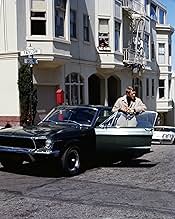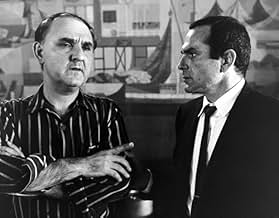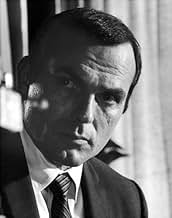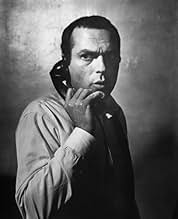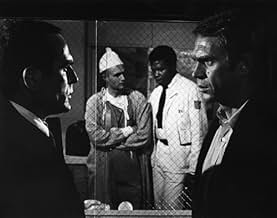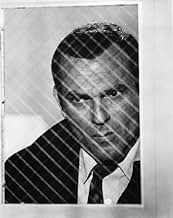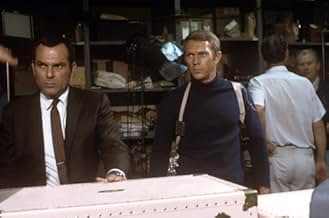Un policía de San Francisco con agallas pero sin gloria está decidido a encontrar a un cabecilla del hampa que asesinó al testigo que estaba bajo su protección.Un policía de San Francisco con agallas pero sin gloria está decidido a encontrar a un cabecilla del hampa que asesinó al testigo que estaba bajo su protección.Un policía de San Francisco con agallas pero sin gloria está decidido a encontrar a un cabecilla del hampa que asesinó al testigo que estaba bajo su protección.
- Dirección
- Guionistas
- Elenco
- Ganó 1 premio Óscar
- 7 premios ganados y 9 nominaciones en total
Vic Tayback
- Pete Ross
- (as Victor Tayback)
- Dirección
- Guionistas
- Todo el elenco y el equipo
- Producción, taquilla y más en IMDbPro
Opiniones destacadas
A great example of the sordid, violent, 60's detective film, and a prime influence on every t.v. detective series from the 1970's onward. Grittily realistic with San Francisco making an excellent back drop for one of Steve McQueen's best roles. As detective Frank Bullit, assigned to guard a chief witness in a senate investigation, McQueen is a perfect combination of stoicism and jaded cool. Robert Vaughn makes an excellent corrupt politician attempting to gain publicity with a mob investigation, and Jacquline Bisset is beautiful as McQueen's girlfriend and voice of normalcy. The stylish medium shot direction of Peter Yates ( his best film) makes for a fast past action /suspense/ police thriller. And of course there's the justifiably famous car chase.
Probably the most beautiful car chase in all of Hollywood cinema. That alone is worth the price of admission to the theater. Apart from that, I came to this movie after the chapter Quentin Tarantino dedicated to it in his recent book. Deservedly so, I would say. The forerunner of tough and pure cops, Bullitt has charisma and charm to spare, thanks in large part to Steve McQueen. The role fits him perfectly. The soundtrack is also one of the most iconic around, Lalo Schifrin knew what he was doing. Thank you Quentin for introducing me to this old film, which I include among the classics of the genre.
What a change of pace this movie is as compared with its genre today. I'm no old fogey but would that modern directors become smart enough take several pages from its book.
The Bullit character is a precursor of Dirty Harry but a bit more cerebral. Stylistically, the director sets the stage beautifully for McQueen's Bullit. The movie has a European feel (director Peter Yates is a Brit) and achieves its dark mood through quiet understatement. The musical score for instance. Today, music is overly used, overly loud and manipulative. (i.e. in case you are not moved by this scene, here are a division of amplified violins to remind you to weep). In 'Bullit' the music is sparingly used and doesn't intrude at all. It complements the directorial style without setting the agenda.
The feeling of reserved naturalism is achieved through editing and dialogue. There really aren't very many lines in the movie and when characters do speak they are very succinct. Notice the last 15-20 minutes of the movie, most of which takes place at the airport. Hardly a line in it. There is none of the chattiness so prevalent today (especially post "Pulp Fiction") which is so tedious (unless the script is tip-top, which is rare).
Editing is, perhaps, its greatest strong point. The many long edits deserve equal credit with the dialogue in setting the low-key mood. The cinema verite dialogue of the airport scenes (and, say, the scene where McQueen and Don Gordon search the trunk) combined with the long cuts add greatly to understated feel while adding realism.
And the performances are top notch. The spare script helps McQueen shine since the taciturn moodiness fits his persona to a tee. There are very fine performances from all of the supporting cast, from Don Gordon to Bisset to Fell to Duvall to Oakland. This is a great movie for watching faces. Note the expressions of the hit men during the chase scene (just another example of this movie letting the little touches speak volumes).
The chase scene certainly deserves its billing as one of the best in movie history. Recently, 'The Transporter' was lauded for its opening chase sequence. The one in 'Bullit' is a marvel compared. In 'The Transporter' sequence I'm not sure there is a cut that lasts more than three seconds. In 'Bullit' it is again the editing which sets it apart here. The long edits give you the feel of acceleration and deceleration, of tire smoke and gears, of wind and the roller coaster San Francisco streets. You are given the time to place yourself in the frame. In short, 'Bullit' uses real craftsmanship. Films like 'The Transporter' use hundreds of quick edits to mimic the danger and immediacy of 'Bullit' but it comes across as hot air, confusion instead of clarity. The two scenes are perfect set pieces of easy (and hollow) Mtv-style flash versus real directorial substance.
The Bullit character is a precursor of Dirty Harry but a bit more cerebral. Stylistically, the director sets the stage beautifully for McQueen's Bullit. The movie has a European feel (director Peter Yates is a Brit) and achieves its dark mood through quiet understatement. The musical score for instance. Today, music is overly used, overly loud and manipulative. (i.e. in case you are not moved by this scene, here are a division of amplified violins to remind you to weep). In 'Bullit' the music is sparingly used and doesn't intrude at all. It complements the directorial style without setting the agenda.
The feeling of reserved naturalism is achieved through editing and dialogue. There really aren't very many lines in the movie and when characters do speak they are very succinct. Notice the last 15-20 minutes of the movie, most of which takes place at the airport. Hardly a line in it. There is none of the chattiness so prevalent today (especially post "Pulp Fiction") which is so tedious (unless the script is tip-top, which is rare).
Editing is, perhaps, its greatest strong point. The many long edits deserve equal credit with the dialogue in setting the low-key mood. The cinema verite dialogue of the airport scenes (and, say, the scene where McQueen and Don Gordon search the trunk) combined with the long cuts add greatly to understated feel while adding realism.
And the performances are top notch. The spare script helps McQueen shine since the taciturn moodiness fits his persona to a tee. There are very fine performances from all of the supporting cast, from Don Gordon to Bisset to Fell to Duvall to Oakland. This is a great movie for watching faces. Note the expressions of the hit men during the chase scene (just another example of this movie letting the little touches speak volumes).
The chase scene certainly deserves its billing as one of the best in movie history. Recently, 'The Transporter' was lauded for its opening chase sequence. The one in 'Bullit' is a marvel compared. In 'The Transporter' sequence I'm not sure there is a cut that lasts more than three seconds. In 'Bullit' it is again the editing which sets it apart here. The long edits give you the feel of acceleration and deceleration, of tire smoke and gears, of wind and the roller coaster San Francisco streets. You are given the time to place yourself in the frame. In short, 'Bullit' uses real craftsmanship. Films like 'The Transporter' use hundreds of quick edits to mimic the danger and immediacy of 'Bullit' but it comes across as hot air, confusion instead of clarity. The two scenes are perfect set pieces of easy (and hollow) Mtv-style flash versus real directorial substance.
Steve McQueen is Frank Bullitt! Frank Bullitt is slick! 'Bullitt' is thrilling! The stylish mystery thriller that created a basis for all future police procedurals to follow! With fantastic direction from Peter Yates and immaculate attention to detail on the stunning cinematography, 'Bullitt' is an attention-demanding and action-packed adventure supported by a jazz-fuelled score. When reviewing this crime flick, who could overlook the unforgettable Mustang v Charger chase through the streets of San Francisco which is arguably the greatest and most influential car chase ever filmed. 'Bullitt' is a dark and suspenseful masterpiece from Peter Yates.
The late 1960s saw two classic, hard-boiled thrillers set in San Fransico; John Boorman's stylised 'Point Blank', and Peter Yates' 'Bullitt'. Calling your hero Bullitt might seem an unsubtle way to emphasise his macho qualities, but in fact Steve MacQueen plays him as a quiet man, not some wise-talking maverick: he does what he has to do, but takes no pleasure in his actions; and survives the roughness of his work not by becoming a monster, but simply by becoming a little less human. It's a believable portrait, and the film as a whole has a procedural feel: there are action scenes, but these are kept in their place in the overall design.
Today, the film is most famous for its celebrated car chase, which makes excellent use, as indeed does the movie as a whole, of the bay area locations, but is not actually shot that excitingly: the conclusion at the airport is more original, though it roots the film in the time when it was permissible to take a loaded gun onto a plane. But overall this is still a classy film, dry, exciting and bleak, and among the very best films of its day. William Friedkin's brilliant 'The French Connection', made a short while afterwards, would appear to owe it a debt.
Today, the film is most famous for its celebrated car chase, which makes excellent use, as indeed does the movie as a whole, of the bay area locations, but is not actually shot that excitingly: the conclusion at the airport is more original, though it roots the film in the time when it was permissible to take a loaded gun onto a plane. But overall this is still a classy film, dry, exciting and bleak, and among the very best films of its day. William Friedkin's brilliant 'The French Connection', made a short while afterwards, would appear to owe it a debt.
¿Sabías que…?
- TriviaWhile filming the scene where the giant airliner taxis just above Steve McQueen, observers were shocked that no double was used. Asked if the producers couldn't have found a dummy, McQueen wryly replied, "They did."
- ErroresDuring the chase sequence, the same green Volkswagen Beetle is seen at least 4 different times in 4 different locations in a period of not more than 1 minute.
- Versiones alternativasDuring the car chase, when the Charger goes wide on a corner and hits a camera, the film was salvaged and red frames added at the end, to give a "point of impact" impression. Despite this gag being in situ for decades, on the current Cinemax Asia print, someone has seen fit to completely remove these last frames of the shot.
- ConexionesEdited into Ciudad en llamas (1979)
Selecciones populares
Inicia sesión para calificar y agrega a la lista de videos para obtener recomendaciones personalizadas
- How long is Bullitt?Con tecnología de Alexa
- Who played the doorman at the Mark Hopkins in "Bulllitt" and gave the hitmen info about the cab, "Sunshine Cab 6912?"
- Why did Johnny Ross (Renick) go to the Mark Hopkins at the beginning of "Bullitt" to pick up a letter?
- Who notified the two killers which hotel Renick/Ross was being held?
Detalles
- Fecha de lanzamiento
- País de origen
- Idioma
- También se conoce como
- Đại Tá Bullitt
- Locaciones de filmación
- Coffee Cantata, Union Street, San Francisco, California, Estados Unidos(jazz club and restaurant scene)
- Productora
- Ver más créditos de la compañía en IMDbPro
Taquilla
- Presupuesto
- USD 5,500,000 (estimado)
- Total en EE. UU. y Canadá
- USD 511,350
- Fin de semana de estreno en EE. UU. y Canadá
- USD 408,627
- 7 oct 2018
- Total a nivel mundial
- USD 512,162
Contribuir a esta página
Sugiere una edición o agrega el contenido que falta

Principales brechas de datos
By what name was Bullitt (1968) officially released in India in English?
Responda



